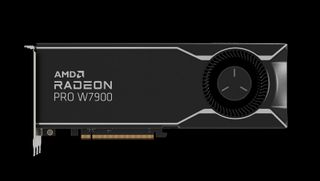Radeon Pro W7000 GPUs Debut With up to 48GB VRAM, Triple-Slot Blowers
RDNA3 hits the workstation market

AMD has announced two brand-new professional RDAN3 graphics cards featuring up to 48GB of memory and blower-style coolers. The two models include the Radeon Pro W7900 and Radeon Pro W7800, with 96 and 70 compute units, respectively. Both GPUs are designed for content creators and professionals requiring high levels of computing capability and memory capacity to drive high-performance workloads.
The Radeon Pro W7900 is the top trim in the series right now, sporting 96 CUs, 12,288 shader cores, and 48GB of memory operating on a 384-bit wide bus for a peak memory bandwidth rating of 864GB/s. AMD rates this GPU at up to 61 TFLOPS of FP32 performance with a total board power rating of 295W. This GPU is the Pro version of the RX 7900 XTX, featuring the same core count and memory bus width as its consumer counterpart. However, the most significant difference with the W7900 is its huge 48GB memory capacity, enabling it to perform much more professional work compared to the 7900 XTX.
Clock speeds are unknown, but expect base and boost clocks to be noticeably lower compared to the reference RX 7900 XTX due to the W7900's lower board power rating and the integration of a triple-slot blower-style cooler.
The Radeon Pro W7800 is a mid-range part featuring 70CUs, 8960 shader cores, and a 256-bit bus featuring 32GB of memory and 576GB/s of memory bandwidth. AMD rates this GPU at up to 45 TFLOPS of FP32 compute performance, with a TBP rating of 260W. This is a mid-range GPU with a full-tier downgrade in GPU specs across the board, with fewer shader cores than an RX 7900 XT. But, the GPU still offers a great deal of compute power nonetheless and 32GB of video memory, which will be optimal for memory-sensitive workloads.
AMD did not mention clock speeds and cooler-type, but expect this card to feature a blower-style cooler like the W7900, albeit with a trimmed-down dual-slot form factor.
The interesting part of the W7800 is that we get a sneak peek of what the consumer variant might look like. The W7800 is the first RDNA3 mid-range GPU we've seen from AMD so far, and it shows what memory bus size and core count AMD is targeting for its upper-end mid-range GPUs. If the core count and memory specs align perfectly, as with the W7900 and RX 7900 XTX, then we can expect the future RX 7800 or 7800 XT to feature 8960 cores and a 256-bit bus.
The Radeon Pro W7900 and W7800 are now available, and the cards should start showing up in OEM and SI systems in the second half of the year. The W7900 will be priced at $3,999, and the W7800 will be priced at $2,499.
Stay on the Cutting Edge
Join the experts who read Tom's Hardware for the inside track on enthusiast PC tech news — and have for over 25 years. We'll send breaking news and in-depth reviews of CPUs, GPUs, AI, maker hardware and more straight to your inbox.

Aaron Klotz is a freelance writer for Tom’s Hardware US, covering news topics related to computer hardware such as CPUs, and graphics cards.
-
Firestone Dang this could be a cheaper alternative to the RTX 6000 Ada if only it had mainstream AI software support.Reply -
atomicWAR Wow what a blow hard...Reply
All joking aside its a trip watching the number of PCIe slots GPUs eat up grow. Man I miss those old single slot cards where you could jam in a ton of other AIB to upgrade your PC. Now your lucky to have a slot free on a modern mainstream board if your running a 3 slot GPU solution with so many mobos putting PCIe 5.0 m.2 slot above the first PCIe 16x slot due to PCIe 5.0 re-timers being 'so' expensive and the nvme drives run HOT thus vendors keeping the m.2 slots as close to the CPU as possible and out from under the GPU itself where ventilation is poor. -
brandonjclark Reply
ISA Sound cards, AGP graphics.... yer making me nostalgic!atomicWAR said:Wow what a blow hard...
All joking aside its a trip watching the number of PCIe slots GPUs eat up grow. Man I miss those old single slot cards where you could jam in a ton of other AIB to upgrade your PC. Now your lucky to have a slot free on a modern mainstream board if your running a 3 slot GPU solution with so many mobos putting PCIe 5.0 m.2 slot above the first PCIe 16x slot due to PCIe 5.0 re-timers being 'so' expensive and the nvme drives run HOT thus vendors keeping the m.2 slots as close to the CPU as possible and out from under the GPU itself where ventilation is poor. -
MetalScythe Doesn’t have 12,288 shaders… has 6,144 shaders that have dual-issue capabilities on -some- (see: FMA) instructions.Reply
I’m hoping rDNA4 is much more flexible on its dual-issue capabilities, and will hopefully be much more exploitable by frustratingly dumb compilers.
Most Popular



